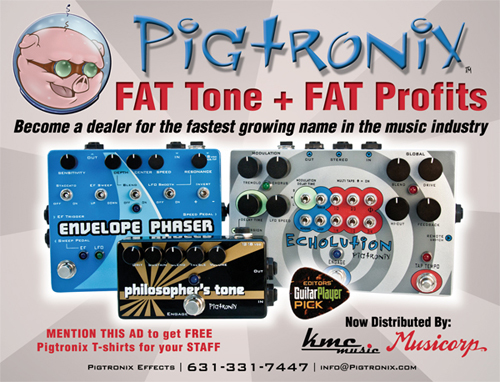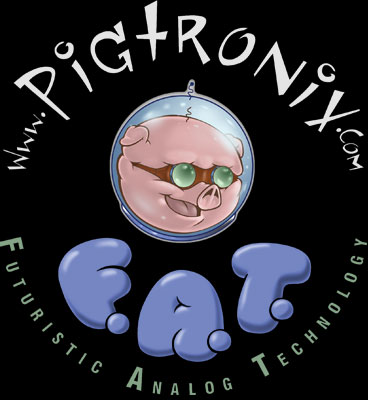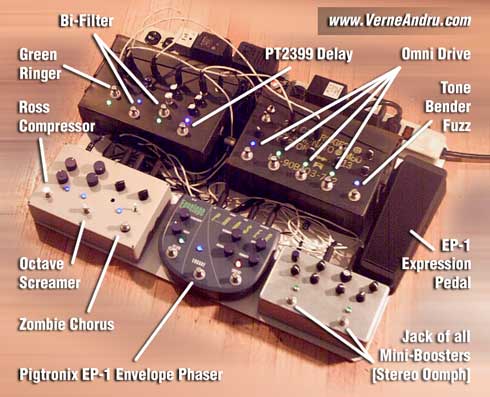|
|
|
Pigtronix & Supro
|

The Supro Connection Verne's Absara Reference Letter Verne met Dave Koltai (founder) when the latter came knocking on the former's apartment door looking to rent a parking space. Dave had arrived in Vancouver BC from the U.S. fresh out of guitar college in Vermont. His girlfriend (now wife) was attending UBC on a graduate program and Dave decided to tag along. Dave was your typical wet-behind-the-ears-wanna-be. He had no training, skills or experience putting together something like a consumer-electronics product let alone bringing it to market. Once Dave realized the wealth of skill and knowledge Verne had, particularly that Verne had launched Simply Accounting with Steve Jobs, he went to work to convince Verne to help him realize his dream, making impossible promises along the way. Verne was working from home at the time on his Captain Cannabis project after being exploited by previous "entrepreneurs" who promised the moon but ended up keeping the booty for themselves. To overcome Verne's refusals Dave literally begged, promising he'd always remember what he had done for him as well as giving Verne one of every product he developed, among other things. Verne finally relented. Koltai had met Brian Bethke at college and called him to say he was "ready to start the business." Bethke is a "trust fund baby" - i.e. his father worked for Standard Oil and provided a healthy fund for his [vapid] son to draw down. Normally Bethke wouldn't bring much other than money to the table, but in this case Brian's major in the Chinese language was a good fit for Pigtronix business plan: design products in North America, have the parts made cheaply in China, assemble and label "Made in the US" for marketing. For the launch Verne:
When Verne and Koltai began discussing the project the first challenge was to define how the actual product would look. Dave didn't want 'just another pedal' but felt something as unique as the Envelope Phaser should be packaged in a unique way. Based on their conversations, Verne set about creating some preliminary sketches including these that found their way to the design shortlist.
| 
 

With the general idea settled upon, Verne turned his attention to the mechanical aspects of the product design. Using 3D modeling software, he started working out the general casing dimensions, circuit board size and layout including plug, potentiometer and switch locations. The 3D renders gave everyone an instant visual reference for how the pieces would come together and provide immediate feedback for potential manufacturing problems.       
The model continued going through a refinement process culminating in Verne generating the final working CAD drawings as well as a 3D render that is used on the promotional and packaging material. 
Digital Render 

Final Production Pedal 










| With the actual product design complete, the drawings were sent to a tooling firm that created a positive of the casing. Final tweaks were made and the casing sample was off to the factory in China to be readied for manufacture. Verne then set his attention to the branding phase of the project. Dave and Brian had already chosen the name Pigtronics (Verne suggested Pigtronix, which they ended up using) and had a very preliminary drawing for their space pig. Verne worked closely, redoing the design until Marvin the Space Pig was born. 
Working digitally gave the team a great deal of flexibility when it came to producing the packaging and marketing materials. Verne incorporated the 3D product rendering and the digital version of Marvin first for a promotional brochure which later became expanded into the final retail packaging. 


With the first run of Envelope Phaser's coming off the assembly line, it became time to get ready for the official launch at the Winter 2004 NAMM show in Anaheim California. Again Verne took advantage of his previous design work, incorporating Marvin into a 5 x 3 foot canvas banner that drew crowds of musicians and music industry notables during the course of the show. Absara continued using this banner for over a decade at NAMM and other shows. 
The product was a big hit and so revolutionary that everyone ate it up including the press which put pictures of Verne's EP-1 design on the covers of their magazines and thus starting the beginning of the Pigtronix brand!
Here are a few pieces Verne has done since the company was launched.
| 
Marvin the Space Pig at Sweetwater's training center. 

Steve Luthaker rocking a Marvin the Space Pig sticker. 




Verne ended up doing the bulk of the work getting Pigtronix flagship product ready for 2004 NAMM show in California for very little money as Dave had pleaded poverty and excluded Verne from becoming a part of the ongoing company or even offering a share in the success.
| Not only did Verne design of the product, marketing and launch, he taught Koltai how to do it along the way. Koltai stated several times he used everything Verne created as templates for all products he subsequently released. Aside from his work in artistic fields, Verne received formal training in TV and radio electronics during grade school and technical college and later worked as a bench technician early in his career. Koltai was 22-ish with no training other than taking jazz guitar at college so Verne taught him:

Sadly in 2014, 10 years after Verne launched Pigtronix at NAMM 2004 for Dave and Brian for pennies, Dave announced to Verne that he "would have become a successful pedal builder without Verne's help." This after Verne spent 18 years and hundreds of hours working with Dave before and after the launch as Dave would call at all hours of the day to chat, as a pretext for taking Verne's expertise without compensation. Check out the reference letter Koltai wrote before he decided he had no further need for Verne: The Supro Connection Koltai/Bethke were so green they arrived at their first NAMM without any amplifiers - just a bunch of newly made EP-1 pedals. Koltai ran around to different amp makers asking for something we could use for the show, which is the first involvement with "Supro." Future Supro maker Bruce Zinky wasn't at the his booth when Koltai came knocking but his wife was and lend Dave a Zinky Blue Velvet amp (Bethke would this one or one like it). Bruce later said that if it had been him he would have told Koltai to get lost but he didn't get a chance, so here's the start of what became the new "Supro." Like all newcomers to NAMM, Absara was put in the Hall E basement. They had a great show notwithstanding with talent like then newcomer Tal Wilkenfield and bass player Theron spending a lot of time at the booth. Zinky, and all major players, had booths on the main show floor - something that takes years of seniority to attain (which Absara didn't have). Over the next few years Bruce Zinky started packaging his Zinky amps as Supro. The cabinet color choices were "off" and Bruce isn't particularly good at public stuff, so he struggled to the point he and Koltai/Bethke (who kept using Zinky amps at subsequent NAMMs) arranged to move Pigtronix booth from Hall E to the main hall with Zinky/Supro to offset booth costs. The deal evolved to the point where Koltai was supposed to be marketing Supro's stuff for Bruce, but as he said to me, he had no interest in doing anything but selling his own product. Bruce Zinky started the "new" Supro in 2004 when he registered the "abandoned" Supro wordmark to use for his Zinky amps. Bruce is ex-Fender (designed the SuperSonic) who does high-end builds which are the antithesis of the position Valco/Supro hold in the consumers mind (and why they sound good). The US Patent and Trademark system shows Zinky registered 3 "Supro" trademarks - one for t-shirts and such that failed (a sock/shoe company holds the trademark for Supro swag such as caps, shirts, etc.) and the following 2 for musical gear that are active as of this writing (02/2021):
Over the next few years the Zinky/Supro booth became a Pigtronix booth after Bruce pulled back from doing NAMMs because he left his fate in Koltai's hands. Bruce struggled for years with Supro. Around 2014 Koltai convinced Bethke to put up the money to buy the Supro "brand" from Bruce with an arrangement whereby Bruce would continue doing the amp design for a period of time. This is the start of the big push of new amps and a line of guitars. As a side gig, Koltai was writing ad copy for D'Angelico so that's likely how he got plugged into the Asian guitar supply chains. All Pigtronix/Supro amps and pedals were made in China and assembled in the US AFAIK. Curiously "Pigtronix Supro" were using the Supro logo (which isn't registered and they don't own - it's in the public domain) with a ® (registered trademark) while both their marks are wordmarks. Verne had advised Koltai that taking over "Supro" was a bad business decision for a number of reasons beyond the scope of this yet Brian and Dave forged ahead with a fast and furious build-out that crashed and burned when they hit the mezzanine (as Verne had warned) and Bethke had burned through his trust-fund. During the many late night telephone calls Koltai would put in to Verne he expressed particular concern about where the company was going after they went big with Supro. In particular the inventory was building, bank accounts dwindling and sharks were circling for a few years prior to the D'Angelico buyout. While all this was foreseeable, Koltai and Bethke were in over their heads and not listening to advice so, while the inevitable melt-down occurred, it is hoped the new owners will be a little more level headed in the next chapters in the Pigtronix and Supro stories yet to be told.
|
|
|
|
|
|